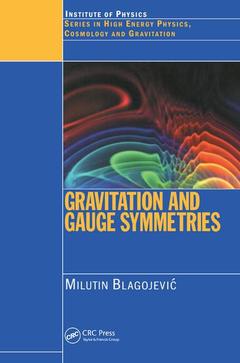Gravitation and Gauge Symmetries Series in High Energy Physics, Cosmology and Gravitation Series
Auteur : Blagojevic M

In the course of the development of electromagnetic, weak and strong interactions, the concept of (internal) gauge invariance grew up and established itself as an unavoidable dynamical principle in particle physics. It is less known that the principle of equivalence, and the basic dynamical properties of the gravitational interaction can also be expressed as a (spacetime) gauge symmetry.
Gravitation and Gauge Symmetries sheds light on the connection between the intrinsic structure of gravity and the principle of gauge invariance, which may lead to a consistent unified field theory. The first part of the book gives a systematic account of the structure of gravity as a theory based on spacetime gauge symmetries. Some basic properties of space, time, and gravity are reviewed in the first, introductory chapter. The next chapter deals with elements of global Poincar nd conformal symmetries, which are necessary for the exposition of their localizations; the structure of the corresponding gauge theories of gravity is explored in chapters 3 and 4. Then, in chapters 5 and 6, we present the basic features of the constrained Hamiltonian of Poincar auge theory, discuss the relation between gauge symmetries and conservation laws, and introduce the concept of gravitational energy and other conserved quantities. The second part of the book explores the most promising attempts to build a unified field theory containing gravity, on the basis of the gauge principle. The author presents the possibility to constrict the theory of gravity as a nonlinear field theory in flat spacetime. The final chapters yield an exposition of the ideas of supersymmetry and supergravity, Kaluza-Klein theory, and string theory.
Gravitation and Gauge Symmetries will be of interest to postgraduate students and researchers in gravitation, high energy physics and mathematical physics.
Date de parution : 05-2019
15.6x23.4 cm
Date de parution : 10-2001
Ouvrage de 522 p.
15.6x23.4 cm
Thèmes de Gravitation and Gauge Symmetries :
Mots-clés :
Energy Momentum Tensor; Parallel Transport; lie; Field Equation; algebra; Covariant Derivative; theories; Conformal Transformations; field; Virasoro Algebra; equation; Conformal Symmetry; energy; Massless Fields; momentum; Poincare Transformations; tensor; Gauge Transformations; metric; Riemann Space; transformations; Lorentz Transformation; conservation laws; Matter Fields; gravitational interaction; Gauge Invariance; gauge symmetries; Noether Current; gauge field theory; Local SU; Conformal Algebra; Inertial Frames; Verma Module; Conformal Invariance; Massless Theory; Yang Mills Theory; Reparametrization Invariance; Closed String; Locally Inertial Frames



